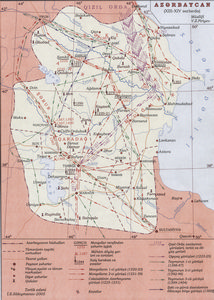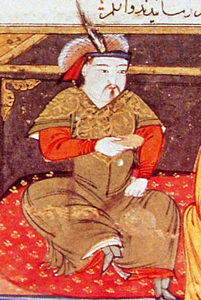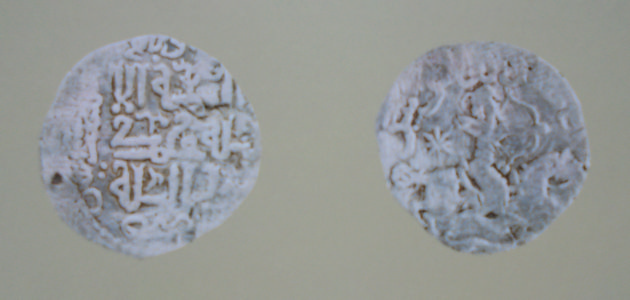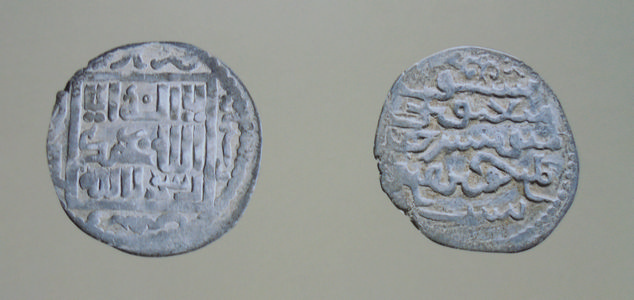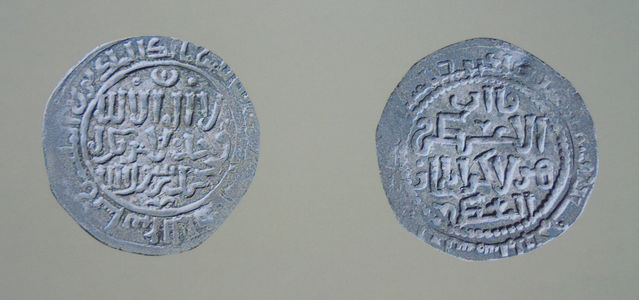Conquest of Azerbaijan by Mongol Empire
Azerbaijan faced a new threat at the beginning of the 13th century. The borders of the new empire created in the east - the Mongol Empire have already reached the borders of Azerbaijan. The Mongols conducted three large-scale operations to conquer Azerbaijan.
The first invasion of Azerbaijan by the Mongols. The first reconnaissance operation, which lasted from 1220 to 1223, was led by Mongol generals Jebe and Subutai with an army of 30,000 troops. "The Mongols invaded the provinces of Azerbaijan and Aran,” historian Ibn al-Athir wrote. “Within a year the rapidly advancing Mongols destroyed the provinces and killed most of the population.” The Mongols moved forward to Derbent and Shirvan and captured the cities. Only the fortress of the local ruler remained untouched. Despite the weakness of the central administration during that period, the Mongols faced big resistance in Azerbaijan.
The city of Shamakhi which was the capital of Shirvanshah state went down in history with its heroic resistance to the invading army. The Mongols besieged the city by using battering rams, siege towers, and scaling ladders. “We must use the sword,” was the position of locals of Shamakhi. “We have no way out except the sword, it is better to persevere and die with honor." The Mongol forces finally breached the fortifications and captured the city in a brutal onslaught. Following that, they sacked and looted the city and caused immeasurable harm to the local population. As a result of the first Mongol invasion of Azerbaijan, the local economy, culture as well as agriculture suffered great losses while also weakening defensive capabilities in the region.
Kipchak and Georgian incursions and the Khwarazmian rule in Azerbaijan. İqtisadi və siyasi qüdrətini itirmiş Eldənizlər artıq hər The Eldiguzids, who had lost their economic and political power, was unable to resist foreign intrusions. Taking advantage of this, the Kipchaks crossed Derbent in 1223 and plundered Shirvan. The local population united and expelled the Kipchaks from Azerbaijan. However, taking advantage of the difficult situation in the region, the Georgians attacked and sacked Azerbaijani regions in 1225
Jalal ad-Din Mingburnu, the son of Khwarazmian Shah Muhammad, entered Azerbaijan in 1225 The last Eldiguzid ruler Atabeg Uzbek gave little resistance and took refuge in Alinja Castle(modern Nakhchivan, Azerbaijan) later dying there. As a result, the rule of the Eldiguzids dynasty in Azerbaijan ended in 1225 After a successful campaign in South Azerbaijan ( modern-day Iran), Jalal ad-Din Mingburnu dealt a heavy blow to the Georgians trying to enter the Aran region. Following this Jalal ad-Din Mingburnu entered Northern Azerbaijan (modern-day Azerbaijan). Local rulers of Shirvan also known as Shirvan Shahs agreed to become a vassal state of Jalal ad-Din Mingburnu and pay a tribute worth 100,000 dinars a year. Following this Jalal ad-Din Mingburnu launched a military campaign in the Middle East. During this time appointed representatives caused unrest among the local populace. This led to a revolt in various regions of Azerbaijan the most notable of which was the Ganja uprising of 1231 Although Jalal ad-Din Mingburnu suppressed the revolt, it causee massive casualties as well as damaging Jalal ad-Din's reputation in the region.
Additionally, instead of uniting the military and political forces in the region against the Mongols, Jalal ad-Din Mingburnu, who presented himself as an enemy of the Mongols, weakened the regional positions. As a result, weak leadership and division in the region couldn't prevent the second Mongol invasion.
The second Mongol invasion of Azerbaijan.Mongol troops led by Chormaqan Noyan invaded Azerbaijan in 1231 Despite the resistance of the local population, Maraga and Ganja were captured while Tabriz was besieged. The nobles of Tabriz saved the city from looting and massacre by giving valuable gifts, but many famous artists were taken to the Karakorum, the capital of Mongolia. Bloody battles continued in Shamkir, Tovuz, and Baku regions of Azerbaijan. However, these cities were also captured the invading army. The Mongols suffered great losses especially in the cities of Shamkir and Beylagan. The cities were devasted as result it was almost impossible to rebuild them. By seizing the city of Derbent in 1239, the occupation of Azerbaijan by the Mongols ended.
Azerbaijan was ruled by people appointed by Great Khagan of the Mongol Empire in 1239-1256. The Mongols replaced the local administrative system in the conquered territories. The Shirvanshahs, who suffered heavy losses from the Mongol invasions, tried to protect their wealth. “Shirvan is an independent province. The owner is Akhsitan," Zakarya Qazvini's wrote about the rule of Shirvanshah Akhsitan II, who ascended to the throne in 1244
Azerbaijan as the center of the Ilkhanate state.Great Khagan sent his brother Hulagu khan with a big army to consolidate the positions in the Middle East and complete the Mongol invasion. Hulagu Khan conquered Azerbaijan and Aran in 1256 He moved from Tabriz in 1258, captured Baghdad, and put an end to the Abbasid caliphate. Hulagu khan began to rule in the territories from the Amu Darya River to the Mediterranean Sea, from the Persian Gulf to Derbent, and created the fifth Mongol state - the Hulagu state. The main center of the Ilkhanates was Azerbaijan. The first capital of the state was Maraga, and then in 1259, it was moved to Tabriz. The palace of the Hulagu Khan, the administrative, military-political administration, treasury, and tax departments were all located in Tabriz. The summer residence of the Hulagu Khan was Garabakh while the winter residence was Mugan. During the period of Hulagu Khan, the Turkic language gained the status of the state language. The vast majority of the Azerbaijani population in the 13th and 14th centuries and its northern part, Aran, were of a Turkic origin. According to the sources in the 13th century, there were 100,000 Turkic horsemen in Aran, prominent Azerbaijani scholar Nasir al-Din Tusi was the chief adviser of Hulagu khan, and later he was the vizier of Abaga khan, the son of Hulagu khan. Although the Shirvanshahs retained their titles during Ilkanate rule it played mainly a formal role.
Although the central administration was greatly strengthened during the reign of Sultan Oljaitu (1304-1316), whereas following the reign of Abu Said (1316-1335) the administration of the state passed to the Amir Chupan.
The reign of Chupan Malik Ashraf, who came to power in Ilkhanate state in 1343, was remembered as a period of pillaging. According to the sources, Malik Ashraf amassed a fortune equal to 400 camels from Azerbaijan and kept treasures in seventeen places.
After the establishment of the Ilkhanates, the Golden Horde, created as a result of the will of Genghis Khan, could not reconcile with the loss of Azerbaijan, a region rich in resources. As a result of these losses, these two great powers were in constant conflict which caused immeasurable damage to Azerbaijan. Golden Horde conquered Chupanid-held Tabriz for a year, putting an end to the Ilkhanate rule in the region. This event led to the independence of the Shirvan.
